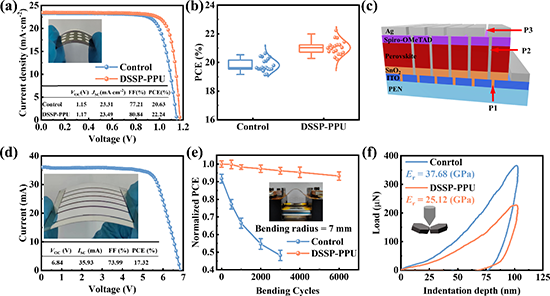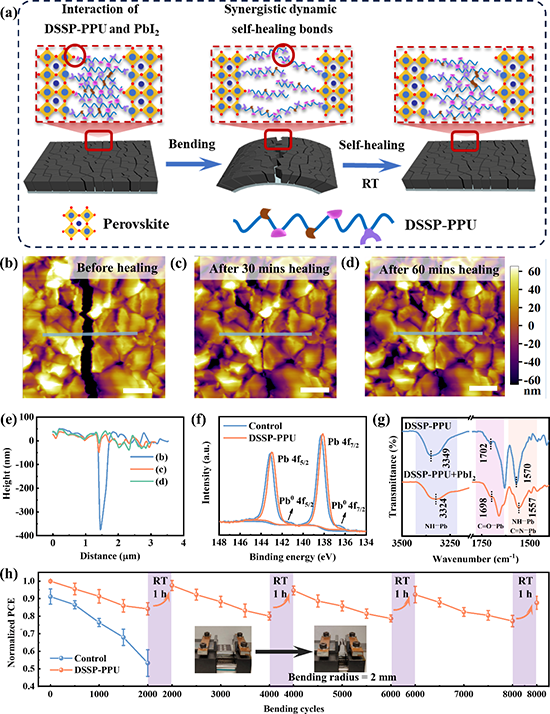具有重量輕、成本低、易于集成的柔性鈣鈦礦太陽電池(F-PSCs)有希望補足傳統剛性硅太陽電池的應用領域,如建筑一體化光伏、可穿戴和便攜式電子設備等。然而,由于鈣鈦礦薄膜固有的脆性和由此引起的韌性斷裂所導致的機械穩定性問題嚴重限制了F-PSC的光伏性能和壽命。因此,解決F-PSCs的機械穩定性是其實現商業化的基礎。
近日,華南師范大學高進偉/姜月團隊通過將超分子PDMS聚氨酯(DSSP-PPU)組成的動態“韌帶”引入鈣鈦礦太陽電池的晶界,促進殘余應力的釋放和晶界的軟化。此外,這種動態“韌帶”表現出優異的自愈合特性,能夠在室溫下愈合鈣鈦礦薄膜中的裂紋。所獲得的鈣鈦礦太陽電池對于剛性襯底和柔性襯底分別實現了23.73%和22.24%的功率轉換效率,對于柔性微型模塊也實現了17.32%的功率轉換效率。值得注意的是,在F-PSCs經受8000次彎曲循環(r = 2 mm)后,F-PSCs仍保持其初始效率的近80%,并且通過室溫自愈合過程進一步恢復至初始效率的近90%。柔性和自愈合“韌帶”策略為提高 F-PSC 的耐用性和性能提供了一種簡單而有效的解決方案并促進F-PSC的商業應用。

Figure 1. a) Chemical structure of PDMS-PPU. b) Top-view (upper row) and cross-sectional (lower row) SEM images of perovskite films on SnO2/ITO with variable concentration of DSSP-PPU. Scale bars: 500 nm. c) XRD spectra of perovskite films with and without DSSP-PPU. d) HR-TEM of perovskite with DSSP-PPU, the right panels showing the enlarged regions of “1 and 2.” e) GIXRD with different instrumental ψ values (0°–50°) for perovskite with and without DSSP-PPU. f) Linear fit of 2θ-sin2ψ for perovskite with and without DSSP-PPU.

Figure 2. a) Chemical structure of PDMS-PPU. b) Top-view (upper row) and cross-sectional (lower row) SEM images of perovskite films on SnO2/ITO with variable concentration of DSSP-PPU. Scale bars: 500 nm. c) XRD spectra of perovskite films with and without DSSP-PPU. d) HR-TEM of perovskite with DSSP-PPU, the right panels showing the enlarged regions of “1 and 2.” e) GIXRD with different instrumental ψ values (0°–50°) for perovskite with and without DSSP-PPU. f) Linear fit of 2θ-sin2ψ for perovskite with and without DSSP-PPU.

Figure 3. a) Chemical structure of PDMS-PPU. b) Top-view (upper row) and cross-sectional (lower row) SEM images of perovskite films on SnO2/ITO with variable concentration of DSSP-PPU. Scale bars: 500 nm. c) XRD spectra of perovskite films with and without DSSP-PPU. d) HR-TEM of perovskite with DSSP-PPU, the right panels showing the enlarged regions of “1 and 2.” e) GIXRD with different instrumental ψ values (0°–50°) for perovskite with and without DSSP-PPU. f) Linear fit of 2θ-sin2ψ for perovskite with and without DSSP-PPU.

Figure 4. a) Chemical structure of PDMS-PPU. b) Top-view (upper row) and cross-sectional (lower row) SEM images of perovskite films on SnO2/ITO with variable concentration of DSSP-PPU. Scale bars: 500 nm. c) XRD spectra of perovskite films with and without DSSP-PPU. d) HR-TEM of perovskite with DSSP-PPU, the right panels showing the enlarged regions of “1 and 2.” e) GIXRD with different instrumental ψ values (0°–50°) for perovskite with and without DSSP-PPU. f) Linear fit of 2θ-sin2ψ for perovskite with and without DSSP-PPU.

Figure 5. a) Chemical structure of PDMS-PPU. b) Top-view (upper row) and cross-sectional (lower row) SEM images of perovskite films on SnO2/ITO with variable concentration of DSSP-PPU. Scale bars: 500 nm. c) XRD spectra of perovskite films with and without DSSP-PPU. d) HR-TEM of perovskite with DSSP-PPU, the right panels showing the enlarged regions of “1 and 2.” e) GIXRD with different instrumental ψ values (0°–50°) for perovskite with and without DSSP-PPU. f) Linear fit of 2θ-sin2ψ for perovskite with and without DSSP-PPU.
華南師范大學姜月副研究員和高進偉教授為論文的通訊作者,華南師范大學博士研究生楊正池為論文第一作者。感謝國家自然科學基金(No. 62105124,)廣東省基礎與應用基礎研究基金(No. 2022B1515120006, 2022A1515010264)等對本文的資助。相關成果以" Supramolecular polyurethane "Ligaments" Enabling Room-Temperature Self-Healing Flexible Perovskite Solar Cells and Mini-modules"為題發表在期刊《Small》上。
原文鏈接: https://doi.org/10.1002/smll.202307186





